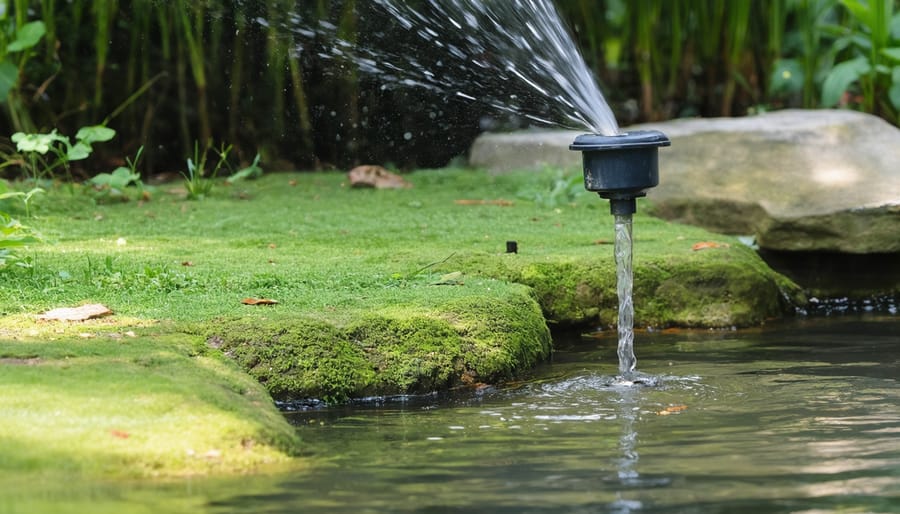
Water Garden Safety: Essential Grounding Tips That Could Save Your Life
Electrical safety grounds serve as your critical defense against deadly shocks and equipment damage in water gardens. Proper grounding transforms potentially hazardous outdoor electrical systems into safe, reliable setups that protect both people and expensive pond equipment. While many DIY enthusiasts focus on the visible aspects of their water features, the hidden grounding system quietly performs life-saving work 24/7, channeling dangerous electrical faults safely into the earth instead of through people or pets.
Installing reliable safety grounds isn’t just good practice – it’s essential for any water feature using electrical equipment like pumps, lights, or filtration systems. This guide will walk you through the fundamentals of electrical grounding for water gardens, from selecting the right materials to proper installation techniques that meet safety codes. Whether you’re setting up your first pond or upgrading an existing system, understanding proper grounding could literally save a life.
Why Electrical Grounding Matters in Water Gardens
Common Electrical Hazards in Water Gardens
Water gardens create beautiful outdoor spaces, but they also present several hidden electrical hazards that every pond owner should know about. The combination of water and electricity requires special attention to prevent dangerous situations. Common hazards include improperly installed or damaged pump cords, unsealed junction boxes exposed to moisture, and incorrectly grounded lighting systems.
Submersible pumps and filters pose particular risks if their cords become frayed or if the equipment isn’t properly rated for underwater use. Extension cords near water features are another concern, especially when they’re not protected by GFCI outlets. During maintenance, wet hands and tools can create dangerous conducting paths for electricity.
Weather conditions can also compromise electrical safety. Rain, snow, and flooding can affect outdoor outlets and wiring, while fallen leaves and debris can hide damaged cables. Regular inspection of all electrical components is essential to maintain a safe water garden environment.
How Proper Grounding Protects You
A proper grounding system acts like a safety net for your electrical equipment, directing dangerous electrical currents safely into the earth instead of through you. When an electrical fault occurs, the grounding wire provides the electricity with a low-resistance path to follow, preventing it from seeking alternate routes through people or equipment.
Think of it like a pressure relief valve – when something goes wrong, the excess electrical energy has a safe way to escape. Without proper grounding, you risk becoming that path of least resistance, which can lead to severe shock or worse.
In your water garden, grounding is especially crucial because water conducts electricity so well. The grounding system connects all metal components to a grounding rod driven deep into the earth, creating a continuous safety chain. If a pump develops a short or a wire becomes damaged, the grounding system quickly diverts the dangerous current away from the water and into the ground, keeping you and your aquatic friends safe.
Essential Grounding Components for Water Gardens
Ground Fault Circuit Interrupters (GFCIs)
Ground Fault Circuit Interrupters (GFCIs) are your first line of defense against electrical accidents in water garden settings. These clever devices monitor the electrical current flowing through a circuit and quickly shut off power if they detect any imbalance – like when electricity starts flowing where it shouldn’t, such as into water or through a person.
For outdoor water features, you’ll need to install GFCI-protected outlets within reach of your pond equipment. The National Electric Code requires GFCI protection for all outdoor receptacles, especially those near water features. Look for weatherproof covers marked “While-In-Use” to keep connections dry during operation.
When installing GFCIs, place them at least 6 feet away from the water’s edge and mount them 18 inches above ground level. This height keeps them safe from flooding and makes them easily accessible. Make sure to test your GFCIs monthly by pressing the “Test” button – if it doesn’t trip, replace the unit immediately.
For added safety, consider installing GFCI circuit breakers at your main electrical panel. These protect entire circuits rather than individual outlets. While they’re a bit pricier than outlet-type GFCIs, they provide comprehensive protection for all your pond equipment on that circuit.
Remember, water and electricity are a dangerous combination, so never skip GFCI protection – it could save a life!

Bonding and Grounding Equipment
When it comes to setting up a safe electrical ground system, having the right equipment is absolutely essential. Let’s start with bonding wire – you’ll want to use solid copper wire that’s at least #8 AWG (American Wire Gauge) or larger. This wire needs to be continuous, without any splices, to ensure proper conductivity.
Ground rods are another crucial component. Choose copper-clad steel rods that are at least 8 feet long and 5/8 inch in diameter. These rods need to be driven into the ground where moisture levels remain fairly constant. For most installations, you’ll need at least two ground rods spaced about 8 feet apart.
Don’t forget about the clamps and connectors! Use UL-listed bronze or brass clamps specifically designed for grounding applications. These clamps need to be rated for direct burial if they’ll be underground. Avoid using regular hardware store clamps, as they may corrode over time.
For connecting your equipment to the grounding system, you’ll need proper grounding lugs or terminals. These should be made of brass or copper and sized appropriately for your wire. Remember to use anti-oxidant compound on all connections to prevent corrosion.
Lastly, consider investing in a ground fault circuit interrupter (GFCI) as an additional safety measure. This device quickly cuts power if it detects any current leakage, providing an extra layer of protection for your water garden.

Safe Installation Practices
Professional vs. DIY Installation
While some electrical grounding tasks can be handled by confident DIY enthusiasts, it’s crucial to know when to call in a professional electrician. As a general rule, homeowners can safely install basic ground fault circuit interrupters (GFCIs) and inspect existing ground connections, but any work involving your home’s main electrical system should be left to the experts.
You can tackle simple tasks like installing ground stakes for pond pumps and lights, connecting pre-wired outdoor electrical equipment, and regularly testing your GFCI outlets. However, if you encounter any of these situations, it’s time to call a licensed electrician:
– Installing new electrical circuits or outlets
– Upgrading your electrical panel
– Replacing or modifying existing ground systems
– Troubleshooting ground faults or electrical issues
– Working with 240-volt circuits
– Any task requiring permit or inspection
Remember, electrical work can be dangerous and potentially fatal if done incorrectly. When in doubt, always err on the side of caution. A professional electrician has the training, tools, and expertise to ensure your grounding system meets all local codes and safety standards.
If you do choose to handle basic grounding tasks yourself, always turn off power at the circuit breaker, use proper safety equipment, and double-check all connections before restoring power. Never attempt electrical work in wet conditions or when standing in water.

Regular Maintenance and Testing
Regular maintenance of your electrical ground connections is crucial for keeping your water garden safe. Make a habit of checking your ground connections monthly, and always after severe weather events. Look for signs of corrosion, loose connections, or physical damage to wiring and ground rods.
Test your ground connections every three months using a ground resistance tester, which you can rent from most hardware stores. The reading should be 25 ohms or less – if it’s higher, you’ll need to address the issue immediately. While testing, ensure all ground clamps are tight and free from rust.
Don’t forget to inspect your GFCI outlets regularly by pressing the “TEST” and “RESET” buttons. These outlets should trip immediately when tested. If they don’t respond properly, replace them right away. Keep detailed records of all your maintenance checks and testing results as part of your emergency safety procedures.
During winter months, pay special attention to exposed ground connections, as freezing and thawing can affect their integrity. Clean any debris or plant material away from electrical boxes and ground rods. If you notice any issues or feel unsure about your ground system’s performance, don’t hesitate to contact a qualified electrician for a professional inspection.
Remember, proper maintenance isn’t just about following regulations – it’s about protecting your family and enjoying your water garden with complete peace of mind.
Safety Tips and Best Practices
When working with electrical equipment around water features, following proper water garden safety measures is absolutely crucial. Always use a ground fault circuit interrupter (GFCI) outlet for any electrical equipment near your pond. These special outlets automatically shut off power if they detect any irregularities, potentially saving lives.
Never handle electrical equipment with wet hands or while standing in water. Keep all power cords and connections well above water level and protected from rain and splashing. It’s a good practice to create a drip loop in your cords – this simple bend prevents water from running down the cord into electrical connections.
Regularly inspect all electrical equipment and wiring for signs of wear, damage, or exposure. Replace any damaged components immediately, and never attempt to repair electrical equipment yourself unless you’re qualified to do so. Keep your pump and lighting equipment clean and free from debris, as build-up can cause overheating.
Consider installing weatherproof covers for all outdoor outlets and connections. During maintenance, always unplug equipment before cleaning or servicing. It’s also wise to mark the location of underwater cables with small flags or markers to prevent accidental damage during future garden work.
Remember to keep children and pets away from electrical equipment, and clearly communicate safety rules to everyone who enjoys your water garden. When in doubt, consult a qualified electrician – it’s better to be safe than sorry!
Proper electrical grounding is not just a technical requirement – it’s a crucial safety measure that protects you, your family, and your water garden equipment. Throughout this guide, we’ve covered the essential aspects of grounding, from understanding basic concepts to implementing specific safety measures for pond equipment. Remember that while DIY projects can be rewarding, electrical work requires careful attention to detail and adherence to safety guidelines. Always use GFCI protection, maintain proper connections, and regularly inspect your grounding systems. If you’re ever unsure about any electrical installation, don’t hesitate to consult a qualified electrician. Your pond should be a source of joy and relaxation, and proper grounding ensures you can enjoy it safely for years to come.
